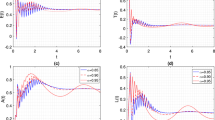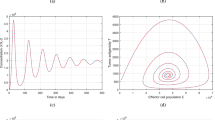Abstract
In this study, we consider a three-dimensional discrete-time model to investigate the interaction between normal host cells with functional immune cells and tumor cells. Fixed point analysis is performed to study the stability of the discrete three-dimensional model and the sensitivity of the system analysis on the initial cell population. Necessary and sufficient conditions for optimal control of tumor cell growth have been created with the introduction of immune-chemotherapy drugs and the chaotic behavior of the system with branching having been demonstrated. The turbulence behavior of the system is shown by branching and Lyapunov power is performed for the integer-order discrete model and the turbulence effect is compared to the different fractional orders of the discrete model. Also, by numerical simulation, validating the theoretical results of the work and the effect of fractional derivative order on system chaos are investigated.













Similar content being viewed by others
Data Availability
Data sharing not applicable to this article as no datasets were generated or analyzed during the current study.
References
Abdeljawad, T., Karapinar, E., Panda, S.K., Mlaiki, N.: Solutions of boundary value problems on extended Branciari b-distance. J. Inequ. Appl. 2020, 103 (2020). https://doi.org/10.1186/s13660-020-02373-1
Ravichandran, C., Logeswari, K., Panda, S.K., Nisar, K.S.: On new approach of fractional derivative by Mittag-Leffler kernel to neutral integro-differential systems with impulsive conditions. Chaos, Solitons Fractals 139, 110012 (2020). https://doi.org/10.1016/j.chaos.2020.110012
Panda, S.K., Karapinar, E., Atangana, A.: A numerical schemes and comparisons for fixed point results with applications to the solutions of Volterra integral equations in dislocated extended b-metric space. Alex. Eng. J. 59(2), 815–827 (2020). https://doi.org/10.1016/j.aej.2020.02.007
Panda, S.K., Abdeljawad, T., Ravichandran, C.: Novel fixed point approach to Atangana-Baleanu fractional and \(L^p\)-Fredholm integral equations. Alex. Eng. J. 59(4), 1959–1970 (2020). https://doi.org/10.1016/j.aej.2019.12.027
Panda, S.K., Abdeljawad, T., Swamy, K.K.: New numerical scheme for solving integral equations via fixed point method using distinct (\(\omega \)-F)-contractions. Alex. Eng. J. 59(4), 2015–2026 (2020). https://doi.org/10.1016/j.aej.2019.12.034
Panda, S.K., Abdeljawad, T., Ravichandran, C.: A complex valued approach to the solutions of riemann-liouville integral, Atangana-Baleanu integral operator and non-linear Telegraph equation via fixed point method. Chaos, Solitons Fractals 130, 109439 (2020). https://doi.org/10.1016/j.chaos.2019.109439
Baleanu, D., Hedayati, V., Rezapour, S., Al-Qurashi, M.M.: On two fractional differential inclusions. Springerplus 5(1), 882 (2016)
Abdeljawad, T., Agarwal, R.P., Karapinar, E., Kumari, P.S.: Solutions of the nonlinear integral equation and fractional differential equation using the technique of a fixed point with a numerical experiment in extended b-metric space. Symmetry 11(5), 686 (2019). https://doi.org/10.3390/sym11050686
Borah, M.J., Hazarika, B., Panda, S.K., Nieto, J.J.: Examining the correlation between the weather conditions and COVID-19 pandemic in India: a mathematical evidence. Results Phys. 19, 103587 (2020). https://doi.org/10.1016/j.rinp.2020.103587
Panda, S.K.: Applying fixed point methods and fractional operators in the modelling of novel coronavirus 2019-nCoV/SARS-CoV-2. Results Phys. 19, 103433 (2020). https://doi.org/10.1016/j.rinp.2020.103433
Mohammadi, H., Kumar, S., Rezapour, S., Etemad, S.: A theoretical study of the Caputo-Fabrizio fractional modeling for hearing loss due to Mumps virus with optimal control. Chaos, Solitons Fractals 144, 110668 (2021). https://doi.org/10.1016/j.chaos.2021.110668
Rezapour, S., Imran, A., Hussain, A., Martinez, F., Etemad, S., Kaabar, M.K.A.: Condensing functions and approximate endpoint criterion for the existence analysis of quantum integro-difference fbvps. Symmetry 13(3), 469 (2021). https://doi.org/10.3390/sym13030469
Matar, M.M., Abbas, M.I., Alzabut, J., Kaabar, M.K.A., Etemad, S., Rezapour, S.: Investigation of the p-Laplacian nonperiodic nonlinear boundary value problem via generalized Caputo fractional derivatives. Adv. Difference Equ. 2021, 68 (2021). https://doi.org/10.1186/s13662-021-03228-9
Thabet, S.T.M., Etemad, S., Rezapour, S.: On a coupled caputo conformable system of pantograph problems. Turk. J. Math. 45(1), 496–519 (2021). https://doi.org/10.3906/mat-2010-70
Baleanu, D., Etemad, S., Rezapour, S.: A hybrid caputo fractional modeling for thermostat with hybrid boundary value conditions. Boundary Value Probl. 2020, 64 (2020). https://doi.org/10.1186/s13661-020-01361-0
Baleanu, D., Etemad, S., Rezapour, S.: On a fractional hybrid integro-differential equation with mixed hybrid integral boundary value conditions by using three operators. Alex. Eng. J. 59(5), 3019–3027 (2020). https://doi.org/10.1016/j.aej.2020.04.053
Baleanu, D., Rezapour, S., Saberpour, Z.: On fractional integro-differential inclusions via the extended fractional Caputo-Fabrizio derivation. Boundary Value Probl. 2019, 79 (2019). https://doi.org/10.1186/s13661-019-1194-0
Aydogan, S.M., Baleanu, D., Mousalou, A., Rezapour, S.: On high order fractional integro-differential equations including the Caputo-Fabrizio derivative. Boundary Value Probl. 2018, 90 (2018). https://doi.org/10.1186/s13661-018-1008-9
Baleanu, D., Mohammadi, H., Rezapour, S.: Analysis of the model of HIV-1 infection of \(CD4^+\) T-cell with a new approach of fractional derivative. Adv. Difference Equ. 2020, 71 (2020). https://doi.org/10.1186/s13662-020-02544-w
Tuan, N.H., Mohammadi, H., Rezapour, S.: A mathematical model for COVID-19 transmission by using the Caputo fractional derivative. Chaos, Solitons Fractals 140, 110107 (2020). https://doi.org/10.1016/j.chaos.2020.110107
Rezapour, S., Mohammadi, H., Jajarmi, A.: A new mathematical model for Zika virus transmission. Adv. Difference Equ. 2020, 589 (2020). https://doi.org/10.1186/s13662-020-03044-7
Baleanu, D., Mohammadi, H., Rezapour, S.: mathematical theoretical study of a particular system of Caputo-Fabrizio fractional differential equations for the Rubella disease model. Adv. Difference Equ. 2020, 184 (2020). https://doi.org/10.1186/s13662-020-02614-z
Kirschner, D., Panetta, J.: Modeling immunotherapy of the tumor immune interaction. J. Math. Biol. 37, 235–252 (1998). https://doi.org/10.1007/s002850050127
Kuznetsov, V., Makalkin, I., Taylor, M., Perelson, A.: Nonlinear dynamics of immunogenic tumors: parameter estimation and global bifurcation analysis. Bull. Math. Biol. 56(2), 295–321 (1994). https://doi.org/10.1016/S0092-8240(05)80260-5
Mayer, H., Zaenker, K.S., Heiden, U.A.D.: A basic mathematical model of the immune response. Chaos: Interdiscip. J. Nonlinear Sci. 5(1), 155–161 (1995). https://doi.org/10.1063/1.166098
Wodarz, D.: Mathematical models of immune effector responses to viral infections: virus control versus the development of pathology. J. Comput. Appl. Math. 184(1), 301–319 (2005). https://doi.org/10.1016/j.cam.2004.08.016
Wodarz, D., May, R.M., Nowak, M.A.: The role of antigen independent persistence of memory cytotoxic T lymphocytes. Int. Immunol. 12(4), 467–477 (2007). https://doi.org/10.1093/intimm/12.4.467
Ferrari, C.: Hbv and the immune response. Liver Int. 35(S1), 121–128 (2015). https://doi.org/10.1111/liv.12749
Khajanchi, S.: Bifurcations and oscillatory dynamics in a tumor immune interaction model. BIOMAT 2015, 241–259 (2016). https://doi.org/10.1142/9789813141919_0016
Khajanchi, S.: Uniform persistence and global stability for a brain tumor and immune system interaction. Biophys. Rev. Lett. 12(4), 187–208 (2017). https://doi.org/10.1142/S1793048017500114
Sardar, M., Khajanchi, S.: Is the allee effect relevant to stochastic cancer model? J. Appl. Math. Comput. (2021). https://doi.org/10.1007/s12190-021-01618-6
Khajanchi, S., Nieto, J.J.: Spatiotemporal dynamics of a glioma immune interaction model. Sci. Rep. 11, 22385 (2021). https://doi.org/10.1038/s41598-021-00985-1
Khajanchi, S.: Stability analysis of a mathematical model for glioma-immune interaction under optimal therapy. Int. J. Nonlinear Sci. Numer. Simul. 20(3–4), 187–208 (2019). https://doi.org/10.1515/ijnsns-2017-0206
Khajanchi, S.: The impact of immunotherapy on a glioma immune interaction model. Chaos, Solitons Fractals 152, 111346 (2021). https://doi.org/10.1016/j.chaos.2021.111346
Khajanchi, S.: Modeling the dynamics of glioma-immune surveillance. Chaos, Solitons Fractals 114, 108–118 (2018). https://doi.org/10.1016/j.chaos.2018.06.028
Khajanchi, S.: Chaotic dynamics of a delayed tumor-immune interaction model. Int. J. Biomath. 13(2), 2050009 (2020). https://doi.org/10.1142/S1793524520500096
Khajanchi, S., Nieto, J.J.: Mathematical modeling of tumor-immune competitive system, considering the role of time delay. Appl. Math. Comput. 340, 180–205 (2019). https://doi.org/10.1016/j.amc.2018.08.018
Khajanchi, S., Perc, M., Ghosh, D.: Modeling the dynamics of glioma-immune surveillance. Chaos: An Interdisciplinary Journal of Nonlinear Science 28, 103101 (2018). https://doi.org/10.1063/1.5052496
Itik, M., Banks, S.P.: Chaos in a three dimensional cancer model. Int. J. Bifurc. Chaos 20(1), 71–79 (2010). https://doi.org/10.1142/S0218127410025417
Salman, S.M.: On a discretized fractional-order SIR model for influenza. Progress in Fractional Differentiation and Application 3(2), 163–173 (2017). https://doi.org/10.18576/pfda/030207
Elaydi, S.: An Introduction to Difference Equation. Springer, Switzerland (2008)
Khajanchi, S., Ghosh, D.: The combined effects of optimal control in cancer remission. Appl. Math. Comput. 271, 375–388 (2015). https://doi.org/10.1016/j.amc.2015.09.012
Khajanchi, S., Banerjee, S.: A strategy of optimal efficacy of T11 target structure in the treatment of brain tumor. J. Biol. Syst. 27(2), 225–255 (2019). https://doi.org/10.1142/S0218339019500104
Pontryagin, L.S., Boltyansky, V.G., Gamkrelidze, R.V., Mischenko, E.F.: The Mathematical Theory of Optimal Processes. John Wiley, New York (1962)
Sethi, S.P.: Optimal Control Theory. Springer, Berlin (2019)
Gomez-Aguilar, J.F., Lopez-Lopez, M.G., Alvarado-Martinez, V.M., Baleanu, D., Khan, H.: Chaos in a cancer model via fractional derivatives with exponential decay and Mittag-Leffler law. Entropy 19(12), 681 (2017). https://doi.org/10.3390/e19120681
Ghanbari, B.: On the modeling of the interaction between the tumor growth and the immune system using some new fractional and fractional-fractal operators. Adv. Difference Equ. 2020, 585 (2020). https://doi.org/10.1186/s13662-020-03040-x
Ucar, E., Ozdemir, N., Altun, E.: Fractional order model of immune cells influenced by cancer cells. Math. Model. Nat. Phenomena 14(3), 308 (2019). https://doi.org/10.1051/mmnp/2019002
Ahmed, E., Hashish, A., Rihan, F.A.: On fractional order cancer model. J. Fract. Calculus Appl. 3(2), 1–6 (2012)
Arshad, S., Sohail, A., Javed, S.: Dynamical study of fractional order tumor model. Int. J. Comput. Methods 12(5), 1550032 (2015). https://doi.org/10.1142/S0219876215500322
Selvam, A.G.M., Alzabut, J., Dhineshbabu, R., Rashid, S., Ur Rehman, M.: Discrete fractional order two-point boundary value problem with some relevant physical applications. Journal of Inequalities and Applications 2020, 221 (2020). https://doi.org/10.1186/s13660-020-02485-8
Selvam, A.G.M., Baleanu, D., Alzabut, J., Vignesh, D., Abbas, S.: On Hyers-Ulam Mittag-Leffler stability of discrete fractional Duffing equation with application on inverted pendulum. Adv. Difference Equ. 2020, 456 (2020). https://doi.org/10.1186/s13662-020-02920-6
Alzabut, J., Abdeljawad, T., Baleanu, D.: Nonlinear delay fractional difference equations with applications on discrete fractional Lotka-Volterra competition model. J. Comput. Anal. Appl. 25(5), 889–898 (2018)
Tripathy, M.C., Mondal, D., Biswas, K., Sen, S.: Experimental studies on realization of fractional inductors and fractional order bandpass filters. Int. J. Circuit Theory Appl. 43(9), 1183–1196 (2015). https://doi.org/10.1002/cta.2004
Ahmed, E., El-Sayed, A.M., El-Saka, H.A.A.: Equilibrium points, stability and numerical solutions of fractional-order predator-prey and rabies models. J. Math. Anal. Appl. 325(1), 542–553 (2007). https://doi.org/10.1016/j.jmaa.2006.01.087
Elsadany, A.A., Matouk, A.E.: Dynamical behaviors of fractional-order Lotka-Volterra predator-prey model and its discretization. J. Appl. Math. Comput. 49, 269–283 (2015). https://doi.org/10.1007/s12190-014-0838-6
Agarwal, R.P., El-Sayed, A.M., Salman, S.M.: Fractional order chua’s system: discretization, bifurcation and chaos. J. Egypt. Math. Soc. 2013, 320 (2013). https://doi.org/10.1186/1687-1847-2013-320
Liu, X., Xiao, D.: Complex dynamic behaviors of a discrete-time predator-prey system. Chaos, Solitons Fractals 32(1), 80–94 (2007). https://doi.org/10.1016/j.chaos.2005.10.081
El Raheem, Z.F., Salman, S.M.: On a discretization process of fractional-order logistic differential equation. J. Egypt. Math. Soc. 22(3), 407–412 (2014). https://doi.org/10.1016/j.joems.2013.09.001
Pimenov, A., Kelly, T.C., Korobeinikov, A., O’Callaghan, M.J.A., Pokrovskii, A.V., Rachinskii, D.: Memory effects in population dynamics: spread of infectious disease as a case study. Math. Model. Nat. Phenomena 7(3), 204–226 (2012). https://doi.org/10.1051/mmnp/20127313
Abdeljawad, T.: On Riemann and Caputo fractional differences. Comput. Math. Appl. 62(3), 1602–1611 (2011). https://doi.org/10.1016/j.camwa.2011.03.036
Chen, F., Luo, X., Zhao, Y.: Existence results for nonlinear fractional difference equation. Adv. Difference Equ. 2011, 713201 (2011). https://doi.org/10.1155/2011/713201
Anastassiou, G.: Principles of delta fractional calculus on time scales and inequalities. Math. Comput. Model. 52(3–4), 556–566 (2010). https://doi.org/10.1016/j.mcm.2010.03.055
Ouannas, A., Khennaoui, A.A., Bendoukha, S., T. P. Vo, V.T.P., Huynh, V.V.: Principles of delta fractional calculus on time scales and inequalities. Applied Sciences 8(12), 2640 (2018). https://doi.org/10.3390/app8122640
Acknowledgements
The fourth author was supported by Miandoab Branch, Islamic Azad University. The fifth author was supported by Azarbaijan Shahid Madani University. The authors express their gratitude to dear unknown referees for their helpful suggestions which improved the final version of this paper.
Funding
Not applicable.
Author information
Authors and Affiliations
Contributions
The authors declare that the study was realized in collaboration with equal responsibility. All authors read and approved the final manuscript.
Corresponding author
Ethics declarations
Conflict of interest
The authors declare that they have no competing interests.
Ethics approval and consent to participate
Not applicable.
Consent for publication
Not applicable.
Additional information
Publisher's Note
Springer Nature remains neutral with regard to jurisdictional claims in published maps and institutional affiliations.
Rights and permissions
About this article
Cite this article
Alzabut, J., Selvam, A.G.M., Dhakshinamoorthy, V. et al. On Chaos of Discrete Time Fractional Order Host-Immune-Tumor Cells Interaction Model. J. Appl. Math. Comput. 68, 4795–4820 (2022). https://doi.org/10.1007/s12190-022-01715-0
Received:
Revised:
Accepted:
Published:
Issue Date:
DOI: https://doi.org/10.1007/s12190-022-01715-0




